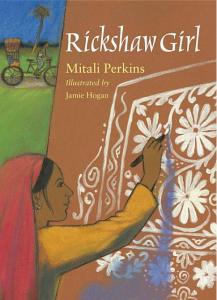Reviewed by Paige Pagan
Review Source: Teaching for Change
Book Author: Mitali Perkins
Naima is the best painter of traditional alpana patterns in her community in Bangladesh. When a painting competition comes up, Naima works hard to win the cash prize and contribute some money to her impoverished family. Naima’s father, a rickshaw driver, is getting older and more tired, working from morning till night. Naima’s mother wishes they had sons instead of two daughters to help her husband, who is the sole breadwinner. Naima sees how dire conditions are getting for her family with the possibility of her parents not being able to send her younger sister to school. She resolves to disguise herself as a boy and drive the rickshaw at night so her father can rest. However, Naima underestimates how hard it would be to steer the rickshaw and crashes it. Now Naima’s father has to work double time to repair it. A new rickshaw repair shop has just opened and Naima’s father hopes that he’ll get a good deal if he takes it there.
Naima thinks about what her strengths are. She disguises herself as a boy again and travels to the new rickshaw repair shop to sell her talent at painting to pay for her fathers repairs. When she arrives at the shop, Naima is surprised to discover that the owner is a woman. Naima takes off her disguise and pleads with the woman to let her help paint rickshaws in place of her father’s repairs. Although painting rickshaws is a lot different than painting alpanas, the woman gives Naima a chance. When Naima’s father discovers what Naima has done, he is initially ashamed that she has defied her traditional gender role. However, when the owner of the shop not only says Naima’s painting will compensate for his repairs but also offers her a paid job at the shop, Naima’s father acknowledges his daughter’s abilities and values her contributions.
I recommend teaching this book, but to also bring to students’ attention that women from all countries, including our own, face oppression in varying ways. There may be a misconception that Middle Eastern, Muslim, and South Asian narratives about females center their subordination in a patriarchal society. It’s important to note that while there may be various narratives that follow this trope, that doesn’t mean that this experience is relegated to any particular region. Teaching students about movements for women’s rights in the United States and internationally, historically and currently, will bring nuance to this topic and show solidarity.
Paige Pagan is a Social Justice Books Program Specialist at Teaching for Change.

Rickshaw Girl by Mitali Perkins
Published by Charlesbridge Publishing on June 17, 2011
Genres: Art, Asia, Girls and Women
Pages: 96
Reading Level: Grades 1-2, Grades 3-5
ISBN: 9781607345077
Review Source: Teaching for Change
Also by this author: Between Us and Abuela, Home Is in Between
Publisher's Synopsis: New York Public Library’s “100 Best Children's Books of the Past 100 Years”
Jane Addams Honor Book Maine Library Association Lupine Honor Book
ALA Amelia Bloomer Project Award Book
Bank Street Best Children's Books List (Starred)
Association of Children's Booksellers Best BookThe moving and critically acclaimed story of a young, artistic Bangladeshi girl who bravely defies tradition in order to support her family through hard times.
Naima is a talented painter of traditional alpana patterns, which Bangladeshi women and girls paint on their houses for special celebrations. But Naima is not satisfied just painting alpana. She wants to help earn money for her family, like her best friend, Saleem, does for his family.
When Naima's rash effort to help puts her family deeper in debt, she draws on her resourceful nature and her talents to bravely save the day. Includes a glossary of Bangla words and an author's note about a changing Bangladesh and microfinance.

Leave a Reply